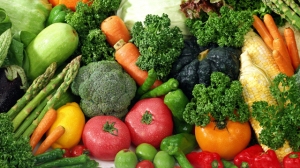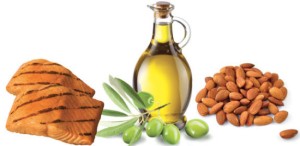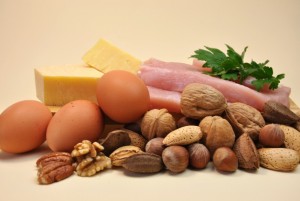 At least three times a week I have to ask my clients, “Did you have a snack before you came to see me?” 75% of the time they exclaim, “Yes!” and proceed to talk about the piece of fruit, protein shake, or granola bar they chowed down 30-60 minutes before they came. The other 25% talk about their large lunches, their lack of time, or how they don’t want to eat while driving (driving I can understand). These 25%ers run the risk of passing out, not having enough energy to push themselves, or even complete their workouts! They also risk eating up that good muscle they’ve been building during their workouts, by not having the adequate nutritional fuel to help them go that extra mile.
At least three times a week I have to ask my clients, “Did you have a snack before you came to see me?” 75% of the time they exclaim, “Yes!” and proceed to talk about the piece of fruit, protein shake, or granola bar they chowed down 30-60 minutes before they came. The other 25% talk about their large lunches, their lack of time, or how they don’t want to eat while driving (driving I can understand). These 25%ers run the risk of passing out, not having enough energy to push themselves, or even complete their workouts! They also risk eating up that good muscle they’ve been building during their workouts, by not having the adequate nutritional fuel to help them go that extra mile.
I cannot stress enough how important it is to fuel up before and after your workout.
Let’s discuss the 3 macronutrients that are essential parts of a healthy diet: carbohydrates; fat; protein.
 Carbohydrates are your body’s preferred fuel source. They can be simple (composed of 1 or 2 sugar molecules) and complex (3 or more sugar molecules).
Carbohydrates are your body’s preferred fuel source. They can be simple (composed of 1 or 2 sugar molecules) and complex (3 or more sugar molecules).
Simple carbohydrates are the easiest for your body to absorb as they have the simplest structure; they also are the carbohydrates you should consume the least! Simple carbohydrates can be found in a wide variety of sweet tasting temptations such as the table sugar you add to your coffee or tea; honey; refined white flour products; milk; yogurt; candy; fruit (and juice!); and the most popular culprit, soda. Now, just because simple carbs should be consumed the least, don’t avoid them entirely! Fruit, for example, has plenty of simple sugars in the form of fructose, but fruits also contain a lot of essential micronutrients such as vitamins and minerals! Milk, another example, contains the dissacharide sugar molecule lactose, but milk also contains protein; an essential macronutrient!
Complex carbohydrates are the preferred form of carbohydrate intake because they are generally rich in fiber and micronutrients such as vitamins and minerals. I believe it is better to not need to supplement your diet with pills in order to get these great micronutrients; instead get them through proper nutrition (aka Eat Your Way to Health!) Complex carbs can be found in vegetables, whole grains, legumes and other vegetation.
 Fat, generally seen as a bad word and to be avoided at all costs, is the most misunderstood macronutrient. Fat is necessary in the diet as it can be used as fuel, can help control hormone production, provides padding and insulation around your vital organs, and transports fat-soluble vitamins (yay, micronutrients!) throughout the body. There are 5 major types of fat: cholesterol, triglycerides, saturated fats, polyunsaturated fats, and monounsaturated fats.
Fat, generally seen as a bad word and to be avoided at all costs, is the most misunderstood macronutrient. Fat is necessary in the diet as it can be used as fuel, can help control hormone production, provides padding and insulation around your vital organs, and transports fat-soluble vitamins (yay, micronutrients!) throughout the body. There are 5 major types of fat: cholesterol, triglycerides, saturated fats, polyunsaturated fats, and monounsaturated fats.
Cholesterol comes in 2 types: high density lipoproteins (HDL) and low density lipoproteins (LDL). HDL decreases the buildup of fatty deposits (LDL) within the cardiovascular system by transporting these fatty deposits back to the liver to be excreted. Your body actually produces cholesterol on its own so it is NOT necessary to have it in the diet! Cholesterol can be found in foods such as full cream milk and milk based products (like cheese and butter), the brains, liver and kidney of mammals, and eggs.
Triglycerides are the most common form of fat and oil found in food. Your body stores triglycerides as fat tissue! But don’t start knocking this fat tissue yet; it happens to be a very useful storage of energy for the body! You burn this energy during your workouts!
Saturated fats increase the LDL cholesterol levels in the body, and are the leading cause of obesity. Saturated fats are found in animal products such as meat and full fat dairy products. You’ll also consume them from eating deep fried foods, chocolate, and bread sweets as they are often made with animal products and fat.
Polyunsaturated fats are considered the essential fats and are classified into 2 groups: omega-3 and omega-6 fatty acids. These fats are found in a wide range of plant and animal based food, and tend to lower cholesterol and triglyceride levels. However, they may also lower the good HDL levels. Omega-3 can be found in fish and seafood products and can reduce the risk of blood clots and treat heart disease, hypertension, and arthritis, to name a few benefits. Omega-6 can be found in plant oils such as safflower, sunflower, corn, soyabean and cottonbean. It can also be found in meat products, which means we generally consume enough omega-6!
Monounsaturated fats are great because they can help lower your LDL cholesterol levels without decreasing the HDL levels at the same time! These fats can be found in nuts, olives, canola, and avocado.
 Proteins, our final macronutrient, consist of one or more chains of amino acids, and are a necessary component of all cells in the body. Amino acids are classified Essential or Non-Essential depending on whether the body can replicate them or not. Essential amino acids must be consumed in the diet. Protein is used in building muscle, skin, hair, nails, bone and teeth. It is used for hormone and enzyme production, the replication of DNA, and the transportation of molecules throughout the body. Complete proteins are proteins that contain all essential amino acids and those can be found in animal based products such as dairy, meat, seafood, eggs. The only non-animal product to contain all the Essential amino acids is soybeans. You can also consume incomplete proteins in combination to make a complete protein meal. Examples of incomplete proteins are legumes, nuts, seeds, cereals. If you were to eat a serving of both rice AND beans, you’d have a complete protein meal.
Proteins, our final macronutrient, consist of one or more chains of amino acids, and are a necessary component of all cells in the body. Amino acids are classified Essential or Non-Essential depending on whether the body can replicate them or not. Essential amino acids must be consumed in the diet. Protein is used in building muscle, skin, hair, nails, bone and teeth. It is used for hormone and enzyme production, the replication of DNA, and the transportation of molecules throughout the body. Complete proteins are proteins that contain all essential amino acids and those can be found in animal based products such as dairy, meat, seafood, eggs. The only non-animal product to contain all the Essential amino acids is soybeans. You can also consume incomplete proteins in combination to make a complete protein meal. Examples of incomplete proteins are legumes, nuts, seeds, cereals. If you were to eat a serving of both rice AND beans, you’d have a complete protein meal.
OK, now that I’ve saturated your noggin with macronutrient basics, let’s turn this new knowledge into power; literally! If you’re going to exercise, you’re going to need to provide your body with the energy it needs to perform. We’ve learned that carbohydrates are your body’s preferred source of fuel, that fats are necessary in the diet and stored fat acts as a reserve of energy for body functions, and that proteins are the building blocks of all cells and regulate many vital functions!
So now what should we eat? How about we give ourselves a nice complex carbohydrates boost with a little necessary fat before we workout, and a nice dose of everything after? Fuel our body with its preferred energy source, then let it recover with the macronutrients it needs to function!
Here‘s a great list of pre and post-workout snacks.